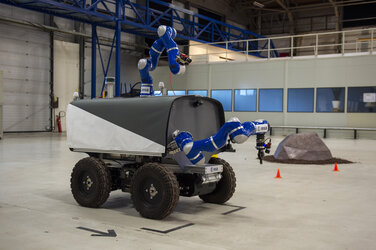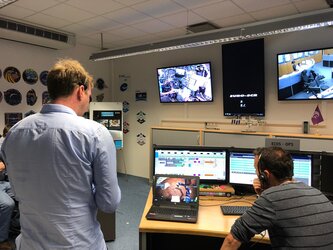Accept all cookies Accept only essential cookies See our Cookie Notice

About ESA
The European Space Agency (ESA) is Europe’s gateway to space. Its mission is to shape the development of Europe’s space capability and ensure that investment in space continues to deliver benefits to the citizens of Europe and the world.
Highlights
ESA - United space in Europe
This is ESA ESA facts Member States & Cooperating States Funding Director General Top management For Member State Delegations European vision European Space Policy ESA & EU Space Councils Responsibility & Sustainability Annual Report Calendar of meetings Corporate newsEstablishments & sites
ESA Headquarters ESA ESTEC ESA ESOC ESA ESRIN ESA EAC ESA ESAC Europe's Spaceport ESA ESEC ESA ECSAT Brussels Office Washington OfficeWorking with ESA
Business with ESA ESA Commercialisation Gateway Law at ESA Careers Cyber resilience at ESA IT at ESA Newsroom Partnerships Merchandising Licence Education Open Space Innovation Platform Integrity and Reporting Administrative Tribunal Health and SafetyMore about ESA
History ESA Historical Archives Exhibitions Publications Art & Culture ESA Merchandise Kids Diversity ESA Brand Centre ESA ChampionsLatest
Space in Member States
Find out more about space activities in our 23 Member States, and understand how ESA works together with their national agencies, institutions and organisations.
Science & Exploration
Exploring our Solar System and unlocking the secrets of the Universe
Go to topicAstronauts
Missions
Juice Euclid Webb Solar Orbiter BepiColombo Gaia ExoMars Cheops Exoplanet missions More missionsActivities
International Space Station Orion service module Gateway Concordia Caves & Pangaea BenefitsLatest
Space Safety
Protecting life and infrastructure on Earth and in orbit
Go to topicAsteroids
Asteroids and Planetary Defence Asteroid danger explained Flyeye telescope: asteroid detection Hera mission: asteroid deflection Near-Earth Object Coordination CentreSpace junk
About space debris Space debris by the numbers Space Environment Report In space refuelling, refurbishing and removingSafety from space
Clean Space ecodesign Zero Debris Technologies Space for Earth Supporting Sustainable DevelopmentApplications
Using space to benefit citizens and meet future challenges on Earth
Go to topicObserving the Earth
Observing the Earth Future EO Copernicus Meteorology Space for our climate Satellite missionsCommercialisation
ESA Commercialisation Gateway Open Space Innovation Platform Business Incubation ESA Space SolutionsLatest
Enabling & Support
Making space accessible and developing the technologies for the future
Go to topicBuilding missions
Space Engineering and Technology Test centre Laboratories Concurrent Design Facility Preparing for the future Shaping the Future Discovery and Preparation Advanced Concepts TeamSpace transportation
Space Transportation Ariane Vega Space Rider Future space transportation Boost! Europe's Spaceport Launches from Europe's Spaceport from 2012Latest

Interact for Analog-1 during proficiency test
Thank you for liking
You have already liked this page, you can only like it once!
ESA astronaut Luca Parmitano took command of a rover in the Netherlands on 18 November 2019 and expertly drove it over an obstacle course to a sampling site and collected a rock – all while circling our planet at 28 800 km/h in the International Space Station.
This test was the first in a series to prove the technology ESA has developed to operate rovers from afar. Called Analog-1 the test could hardly have gone any better. Given one hour of precious astronaut time, Luca ticked all the boxes for the exam in less than half an hour.
Robots can be fitted for special tasks and go places where no humans can go, but nothing beats our quick and adaptive thinking and the human touch. The Analog-1 rover is equipped with force feedback so astronauts can feel what the robot feels and adjust grip accordingly on a joystick that allows for six degrees of motion.
ESA’s exploration strategy foresees astronauts controlling robots from orbit around the Moon or Mars or from inside a planetary base.
A week later all elements of the overarching Meteron project will be put to the test. Luca will drive the robot to three sites in the hangar in the Netherlands and decide in collaboration with a science team based at the European Astronaut Centre in Cologne, Germany, which rocks to pick up and keep for later analysis.
This experiment is as authentic as possible using the International Space Station as a stand-in for a lunar gateway and the hangar made to resemble a lunar landscape. Whereas the first “proficiency run” was used to test the systems and Luca had to follow a determined path, next week he will be more free to explore to meet the objectives set up by the science team at the European Astronaut Centre.
The same science software designed for guiding the ExoMars rover mission on the Red Planet will be used that allows the science team to indicate sites of interest as well as overlay dangerous areas that are beyond the limits of the rover’s capabilities.
The Analog-1 experiment is proving the value of human-robotic cooperation in space and demonstrating the technology that will be used as the basis for many of ESA’s exploration projects.
-
CREDIT
ESA -
LICENCE
ESA Standard Licence

Geological samples for Analog-1

Analog-1 Interact rover

Analog-1 sample collection tool

European Astronaut Centre control room during Analog-1















 Germany
Germany
 Austria
Austria
 Belgium
Belgium
 Denmark
Denmark
 Spain
Spain
 Estonia
Estonia
 Finland
Finland
 France
France
 Greece
Greece
 Hungary
Hungary
 Ireland
Ireland
 Italy
Italy
 Luxembourg
Luxembourg
 Norway
Norway
 The Netherlands
The Netherlands
 Poland
Poland
 Portugal
Portugal
 Czechia
Czechia
 Romania
Romania
 United Kingdom
United Kingdom
 Slovenia
Slovenia
 Sweden
Sweden
 Switzerland
Switzerland


























